
Mixed forest characteristics, flora, climate, fauna
The mixed forest It is one that includes species of angiosperms (broad-leaved deciduous) and gymnosperms (needle-like or scaly-leaved evergreen). In the northernmost strip of latitude it borders the Taiga (coniferous forest) in zones of humid temperate climate.
This type of forest is made up of 2 to 3 layers including canopy and understory (shrubs, grasses, ferns and mosses). It has fertile soils, with abundant organic matter and good moisture retention. Climbers and epiphytes are absent or scarce, with the exception of the Central American mixed forests.
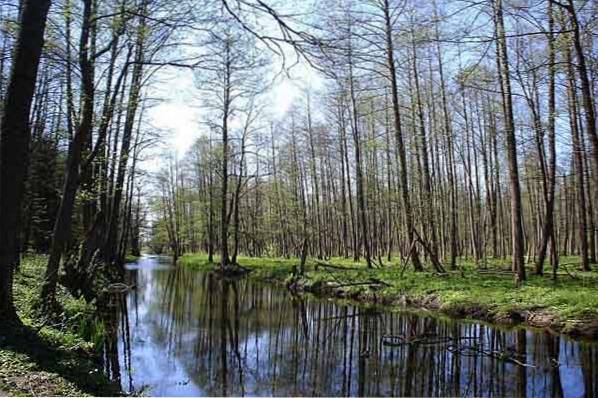
Various types of mixed forests have been described worldwide, varying in climatic conditions and species. There are mixed transitional forests between temperate deciduous forest and Taiga in the northern regions of the northern hemisphere.
In Asia, these mixed forests are transitional between monsoon forests and Taiga. In the Mediterranean basin there are mixed dry summers forests while in Mexico and Central America they vary in their floristic composition in relation to those of the north.
In the southern hemisphere (Chile-Argentina, Australia, Tasmania and New Zealand) the families of gymnosperms present in these forests are different.
In the mixed forests of the northern hemisphere the predominant gymnosperms belong to the Pinaceae and Cupressaceae families. While in the southern hemisphere we find the families Araucariaceae and Podocarpaceae.
Regarding the angiosperms present, the most prominent family is Fagaceae, especially the genus Quercus (oaks, holm oaks and cork oaks).
Mixed forests develop in temperate climates, either oceanic, Mediterranean or humid continental climates. In these habitats there is diverse fauna, which varies according to the geographical region.
In the northernmost latitudes of the northern hemisphere it includes emblematic animals such as the wolf, the bear and the elk. While in Mexico we find the opossum, in the southern American cone the Patagonian skunk and in China they are part of the panda bear habitat..
Most mixed forests have historically been subject to logging. Thus, the cleared areas have been dedicated to agriculture and breeding (cows, pigs and goats). On the other hand, important extensions of mixed forest have been protected under the figure of national parks or reserves. In these areas a relevant economic activity is tourism.
As examples of mixed forests we have the Central American pine and oak forest, which, due to its geographical location, is influenced by the tropical flora. The Mediterranean coniferous and holm oak forest is an example of a dry summer forest. Likewise, the mixed Balkan forest represents a humid temperate forest and the forest of the south of the Yangtze River (China) is influenced by the monsoon forest.
Article index
- 1 General characteristics
- 1.1 - Vegetation structure
- 1.2 - Soil
- 2 Types of mixed forest
- 2.1 Mixed transition forest with the Taiga
- 2.2 Mixed transition forest with the Taiga and the monsoon forest
- 2.3 Mixed temperate rainforest
- 2.4 Mixed transition forest with Central American pines
- 2.5 Mixed transition forest with Araucarias and Podocarpaceae
- 2.6 Mediterranean mixed forest
- 3 Location in the world
- 3.1 - Europe
- 3.2 - America
- 3.3 - Africa
- 3.4 - Asia
- 3.5 - Oceania
- 4 Flora
- 4.1 - Geographic diversity
- 4.2 - Gymnosperms
- 4.3 - Angiosperms
- 5 Climate
- 5.1 - Maritime or oceanic climate
- 5.2 - Mediterranean climate
- 5.3 - Moderate summer humid continental climate
- 6 Fauna
- 6.1 - America
- 6.2 - Europe
- 6.3 - Asia
- 6.4 - Africa
- 6.5 - Oceania
- 7 Economic activities
- 7.1 - Agriculture and livestock
- 7.2 - Extraction of forest resources
- 7.3 - Tourism
- 7.4 - Sport hunting
- 8 Examples of mixed forests in the world
- 8.1 Bialowieza Mixed Forest (Poloni-Belarus)
- 8.2 Mediterranean mixed coniferous and holm oak forest
- 8.3 Mixed Balkan forest
- 8.4 South Yangtze River Mixed Forest (China)
- 8.5 Mixed Central American pine and oak forest (Nicaragua, Honduras, Guatemala)
- 9 References
General characteristics
- Vegetation structure
What is the structure?
When analyzing a forest, one of the elements to consider is its structure that refers to the existing biotypes and their horizontal and vertical distribution. To describe it, the number of vertical strata, the continuity of the canopy, and the presence of climber and epiphytism are considered..
The canopy is the upper layer of the forest formed by the canopies of the upper stratum trees. Likewise, the so-called emergent trees can be presented, which are those that protrude above the canopy.
The structure of the mixed forest
Mixed forests are plant formations with a predominance of the tree biotype with two to three very well defined strata and little climbing and epiphyticism. Bromeliads and epiphytic orchids are found in the mixed forests of Mexico and Central America.
Depending on the climate of the region, the canopy reaches between 25 and 45 m in height, although some are lower as in the Pyrenean mountain range. Likewise, some taller ones such as the mixed Californian forests may be present..
There is an upper layer made up of fully developed trees, a lower layer of intermediate trees and finally an understory. This lower layer is made up of mosses, ferns, grasses and shrubs, while fungi are abundant on the ground..
- I usually
Mixed forests generally have well-developed soils with abundant organic matter. They are fertile soils and in most cases have good water availability.
Mixed forest types
The mixed forest represents a transitional plant formation between coniferous forests (gymnosperms) and angiosperm forests. Gymnosperms are evergreen, while the angiosperms present here are deciduous or marcescent.
Deciduous plants are those that lose all their leaves in autumn-winter. In turn, in the marcescentes leaves dry, but remain on the plant until new leaves are formed..
Generally, mixed forests are vegetative formations with high humidity in a temperate climate. However, there are also mixed forests with a Mediterranean climate that are much drier..
In northern North America, Europe and Asia, the Taiga (coniferous forest) is found as the northern limit of the mixed forest. In contrast, in the Mediterranean, Mexico, Central America, South America and New Zealand the transition occurs between broadleaf forests and various types of gymnosperm forests.
The most recent classifications recognize up to 35 types of mixed forests in Europe alone. In this sense, here we present a classification of general groups.
Mixed transitional forest with the Taiga
In northern Europe, Canada and the United States the transition occurs between the Taiga (north) and temperate deciduous forests (south).
Mixed transition forest with Taiga and monsoon forest
In Asia the transition occurs between the monsoon forest and the taiga, so here the structure of the forest is more complex. This complexity is manifested in the presence of climber (lianas) and various tree strata.
Mixed temperate rainforest
Some of the mixed temperate forest formations have exceptionally high humidity. These forests are found in the northwest of the North American Pacific coast and Andean slopes of southern Chile in America.
Likewise, this type of plant formations occurs in the south of the South Island (New Zealand) and parts of eastern China and Japan. Rainfall can reach up to 2,500 mm per year, and in some places in China up to 8,500 mm.
Mixed transition forest with Central American pines
In Mexico and Central America there is an association between the broadleaf evergreen forest (broadleaf) and the Central American pine forest. In this region the coniferous species are of the Pinaceae family.
Mixed transition forest with Araucarias and Podocarpaceae
This mixed forest is located in the southern cone of America (Chile and Argentina), covering some 400,000 km2. It is also found in New Zealand in small patches of a few square kilometers..
Its flora reflects its transitional condition between the temperate rain forest and the coniferous forests of the region. In this case, the coniferous forests are made up of species from the Araucariaceae and Podocarpaceae families..
In the southern cone of South America, the temperate rain forest is the so-called Valdivian forest. An example of New Zealand transitional forest is Cathedral Cove Forest on the Coromandel Peninsula..
Mediterranean mixed forest
The characteristic species of these forests are adapted to withstand the severe summer drought. Pure Mediterranean forests are composed of species of angiosperms that are deciduous.
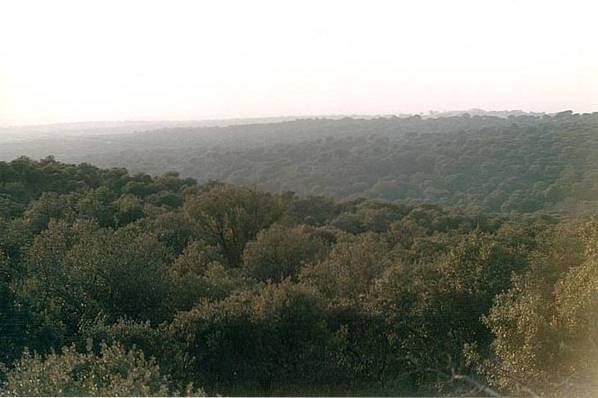
Mediterranean mixed forests occur both in Europe and in the Middle East. The difference with the mixed forest itself is precisely that the former have rainy summers.
In Europe there is mixed Mediterranean forest in the Pindo Mountains (Balkans), in the Southern Apennines (Italy), the Tyrrhenian and the Adriatic. While in the Middle East there is the Anatolian mixed forest in Turkey.
Location in the world
Mixed forests extend discontinuously across all continents. Previously, these forests covered more area, but thousands of years of human activity have resulted in a decrease in their area of distribution..
- Europe
Atlantic coast and central Europe
In this region there is the largest extension of typical mixed forest from the north of Portugal to the Ural Mountains. In the Iberian peninsula it goes from the northwest of Portugal to the west of the Pyrenees through the Cantabrian mountain range.
There are also areas of the French Atlantic coast, channel islands and coasts of Germany and Belgium. Also this type of plant formation extends across the Baltic Sea basin from Germany.
Formerly the extensive plain of central Europe was covered with deciduous temperate forests, including mixed forest. Today, forests are severely reduced or intervened.
One of the few primary mixed forests is the Bialowieza Forest on the border between Poland and Belarus.
Basins of the Mediterranean Sea and the Adriatic
In the Mediterranean basin we find enclaves of mixed forest on the Iberian Peninsula and in the Apennine Mountains (Italy). Also in the Pindo Mountains, encompassing Albania, Greece and North Macedonia.
There are also mixed forests in the coastal lowlands of southern Italy, including Sicily, Sardinia, and other Italian islands. Likewise, these forests are located on the island of Corsica (France) and on the island of Malta.
In the Adriatic Sea we find mixed forest on the southeast coast of Italy and on the Dalmatian Islands (Croatia). Finally, already on the Asian continent, there is an enclave of mixed Mediterranean forest in Anatolia (Turkey).
Central and Eastern Europe
Here is the largest European extension of mixed forest that runs discontinuously across the plain from Central Europe to Eastern Europe. This runs from eastern Germany, Poland, European Russia, Turkey, the Crimean peninsula, and the northwestern Caucasus.
- America
North America
They are found in North America on both the Pacific and Atlantic coasts. In the north they extend through the eastern half of the continent, bordering the area of the great lakes.
Along the Pacific coast is a much smaller area that includes northern California with mixed Mediterranean forest. It then spreads to Oregon, Washington, and British Columbia in Canada.
Southern North and Central America
In southern North America (Mexico) and in Central America, mixed forests extend through mountainous areas to the west. Their highest proportion is located from Mexico to Guatemala, but they are scattered to Nicaragua.
South America
In this part of the American continent, mixed forests are restricted to the southern cone. They are found in south-central Chile and southwestern Argentina, as a transition between the Valdivian forest and araucaria forests..
- Africa
On the African continent, mixed forest is only found in the Mediterranean basin. It is the North African montane forest that extends through the Atlas Mountains from Morocco, through Algeria to Tunisia.
- Asia
In Asia, mixed forests extend discontinuously from Turkey to the Korean peninsula and Japan. In China they are in the northeast, on the east coast and south of the Yangtze River, the subtropical mixed forest is unique in its floristic composition.
- Oceania
Mixed forest is found in small tracts in eastern and southern Australia, New Zealand, and Tasmania.
Flora
- Geographic diversity
The flora of the mixed forest is very varied given the geographical extension and latitudinal variation that it encompasses..
- Gymnosperms
North Hemisphere
In the mixed forests of the northern hemisphere, gymnosperms belong mainly to the Pinaceae families (Pinus Y Abies) and Cupressaceae (Juniperus). However, pine species vary from the forests of Central Europe to the forests of the Far East for example.
In Japan (northern hemisphere) we find gymnosperms of the Podocarpaceae family, more typical of the southern hemisphere. On the other hand, in California the presence of the California redwoods stands out (Sequoia sempervirens) and Douglas fir (Pseudotsuga menziesii).
In the Mediterranean mixed forests are among other species the Scots pine (Pinus sylvestris), salgareño pine (Pinus nigra) and sabina albar (Juniperus thurifera).
Southern hemisphere
In this region the gymnosperms present belong to the Araucariaceae and Podocarpaceae families. In the southern cone of South America there are species such as Araucaria araucana Y Podocarpus saligna.
In New Zealand there are species of Podocarpaceae such as the Matai (Prumnopitys taxifolia), the Totara (Podocarpus totara) and silver pine (Manoao colensoi). Also, you can find the kauri (Agathis australis) of the family Araucariaceae.
- Angiosperms
The diversity of angiosperms in the world is greater than that of gymnosperms and this is manifested in mixed forests. In most cases the Fagaceae family has a relevant representation, in particular the genus Quercus.
North America and North and Central Europe
Quercus robur It is the common oak and the most characteristic species of the Atlantic slope of Europe. Other typical species of these forests are the beech (Fagus sylvatica), birch (Betula spp.), Chestnut (Castanea sativa) and hornbeam (Carpinus betulus).
In Mexico they call encino Quercus robur and it is the most common species in its mixed forests. However, this is only one of 125 species of Quercus that exist in the region.
Mediterranean mixed forest
In the mixed Mediterranean forest the genus predominates Quercus with numerous species. Among these we have the oak (Quercus ilex), the black oak or melojo (Quercus pyrenaica) and the cork oak (Quercus suber).
Other species present in the region are the strawberry tree (Arbutus unedo), wild olive (European wave var. sylvestris) and the mastic (Pistacia lentiscus).
South America
In the mixed forests of Chile-Argentina, the species of Fagaceae and Myrtaceae predominate. There are also various species of the genus Nothofagus (Nothofagaceae).
Asia
In the mixed forests of China, Fagaceae are abundant as Quercus acutissima, Q. variabilis Y Q. dentata, among other. Other species like Liquidambar formosana (Altingiaceae) and Pistacia chinensis (Anacardiaceae) are endemic to Asia.
Due to the influence of the monsoon forests, there are also tropical species such as Albizia macrophylla.
In Japan we find the chestnut (Castanea japonica), birch (Betula maximowicziana) and elm trees (Ulmus parvifolia).
Oceania
A genus with diverse species in the mixed forests of New Zealand as well as Australia and Tasmania is Nothofagus (Nothofagaceae). This genus is also represented in the southern American cone where they are known as southern beech.
Other common species in these mixed forests are the southern sassafras (Atherosperma moschatum) and black acacia (Acacia melanoxylon).
Weather
Mixed forests occur in three basic climatic contexts with their regional variations that are temperate climate variants.
- Maritime or oceanic climate
It is a humid temperate climate, where the marine influence due to its proximity to the coast, attenuates the thermal oscillations. In this region the winds and humidity from the ocean reduce the variation in temperature between day and night..
Likewise, the annual fluctuation in temperature is reduced and benefits from higher humidity..
The average temperature varies between 0 ºC and 22 ºC, being a climate with rainy summers and with rainfall between 800 and 2,000 mm per year. Winters are cool, but not excessively cold.
Geographical occurrence
This type of climate occurs on the west coast of the United States, the European Atlantic coast, New Zealand, Tasmania, Chile and Argentina..
- Mediterranean climate
Mediterranean forests are characterized by a climate with mild and rainy winters and dry summers (hot or temperate). In addition, the autumns are warm, the springs are variable and the average temperature is approximately 20 ºC..
Geographical occurrence
Mixed forests are located in specific places in the Mediterranean basin, California (USA) and in Chile.
- Moderate summer humid continental climate
The average temperature varies between 18-20 ºC and -5 to -10 ºC, while the rainfall is between 480 and 800 mm per year. It presents precipitations all the year, rains in summer and snowfalls in winter.
Geographical occurrence
This type of climate occurs in the eastern quadrant of the US and southern Canada and central and eastern Europe. They are also located in Asia, East China, Korea and Japan.
Fauna
As with the flora, given the geographic extent that the mixed forest fauna encompasses, it varies from region to region. In general, these forests are a refuge for many species with some degree of threat of extinction.
Among others we can mention bear species (Ursus spp.) and different felines. The wolf (Canis lupus), a widely extended species from America to Eurasia, finds one of its habitats in these forests.
- America
USA and Canada
Mixed forests are part of the habitat of a great diversity of species such as the jumping forest mouse (Napaeozapus insignis). There are also large mammals such as the Canadian lynx (Lynx canadensis), Cougar (Puma concolor), black bear (Ursus americanus) and moose (Moose americanus).
Mexico and Central America
Species such as the bobcat are found (Lynx rufus), the white-tailed deer (Odocoileus virginianus) or the armadillo (Dasypus novemcinctus). There are marsupials like the opossum or tiacuache (Didelphis virginiana) and the medium anteater or shihui (Mexican tamandua).
South America
Endemic species such as the Patagonian skunk (Conepatus humboldtii) or the huiña or red cat (Leopardus guigna). It is also the habitat of birds such as the black-necked swan (Cygnus melancoryphus).
- Europe
In Europe, mixed forests are home to threatened species such as the European brown bear (Ursus arctos arctos) and the European bison (Bison bonasus). As well as other species, such as: the wild boar (Sus scrofa), the Fox (Vulpes vulpes) and the Iberian lynx (Lynx pardinus).
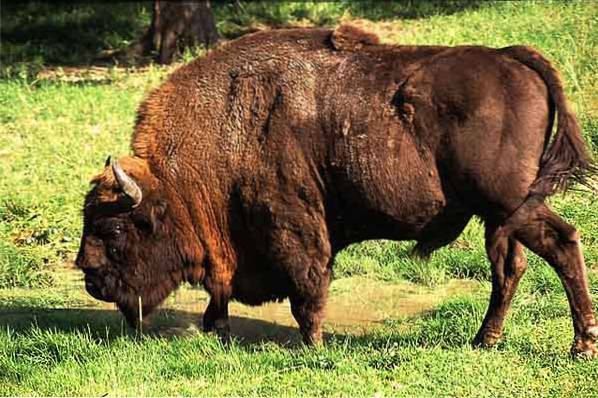
The European otter (Lutra lutra), Marten (Tuesday tuesday) and the eastern imperial eagle (Aquila heliaca). From the Pyrenees it is worth noting the vulture called lammergeier (Gypaetus barbatus).
- Asia
Most of the mixed forest areas in Asia have been severely depleted by human activity. Being densely populated regions the fauna has been devastated by hunting.
In the Korean peninsula, for example, there were tigers, bears and other large mammals, today disappeared.
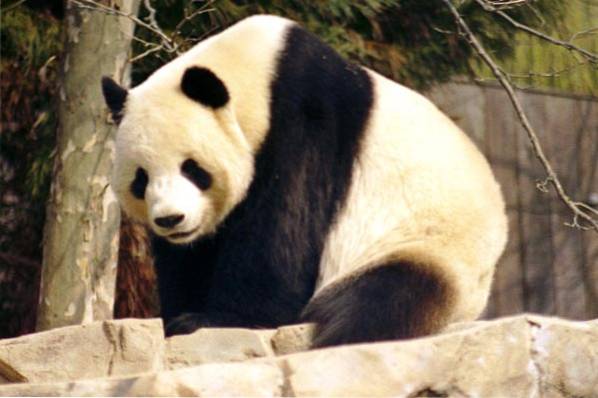
An emblematic species of conservation such as the panda bear (Ailuropoda melanoleuca), includes mixed forest in its habitat. This bear lives in China, in the Qinling and Minshan Mountains, ranging from mixed forest to coniferous and bamboo forest.
- Africa
Primates such as the Barbary Macaque or the Gibraltar Macaque (Macaca sylvanus). Equally feline like the Barbary leopard (Panthera pardus panthera) or ungulates such as the Barbary deer (Cervus elaphus barbarus).
One species that came to inhabit this region was the Atlas bear (Ursus arctos crowtheri), but sadly it became extinct at the end of the 19th century.
- Oceania
The New Zealand mixed forest has a scarce fauna, reduced to certain species of reptiles, bats and amphibians. There are several species that were carried by the colonizers and became naturalized such as the red deer, Australian opossum and the ferret..
Economic activities
- Agriculture and Livestock
Crops
Historically large areas of these forests have been deforested to establish crops. This is because its deep, humid soils rich in organic matter are very fertile..
Typical temperate-floor crops include wheat, barley, rye, sugar beets, and various vegetables.
Cattle raising
Dual-purpose cattle ranching (milk and meat) has been a traditional activity in many mixed forest areas. This is because the climatic conditions are favorable and there is sufficient humidity for the development of good pastures..
- Forest resource extraction
Wood
Throughout history, one of the greatest anthropic impacts on these forests has been logging. In the first place, the wood for cabinetmaking, construction and as fuel that considerably affected the extension of these forests..
Even today forestry is carried out in mixed forests such as on the west coast of the South Island in New Zealand (South Island). In this area the wood of podocarp species such as kauri, rimu, kahikatea and totara is exploited.
The Canadian province of New Brunswick is one of the largest producers of wood and paper pulp in Canada. The wood is extracted from its extensive coniferous forests, mixed and broadleaf forests.
Medicines
Mixed forests are a source of medicinal plants such as the Ilex chinensis in Chinese mixed forests. This is one of the 50 fundamental medicinal plants of traditional Chinese medicine.
- tourism
Currently there are not many areas of mixed forest left, especially in North America and Europe. That is why those that still exist are protected under various figures such as national parks and are used for tourism..
Some examples of this are the mixed forests of California (USA), the Cathedral Cove forest (New Zealand) and the German Black Forest.
- Sport hunting
Due to the abundance of game animals, mixed forests are the object of this activity, highlighting the hunting of wild boar, hares, partridges and other species.
Examples of mixed forests in the world
Bialowieza Mixed Forest (Poloni-Belarus)
This is one of the last strongholds of temperate deciduous forest on the Central European plains. It was a hunting ground for the nobility and today it is a binational nature reserve, declared a world heritage site by UNESCO in 2017.
Gymnosperms such as fir (Abies alba) and angiosperms such as oak (Quercus spp.). In addition, it is the habitat of wild boars (Sus scrofa), deer and the European bison (Bison bonasus).
The last bison of natural populations was hunted in 1921, but in 1929 the Polish government introduced four bison and the population has recovered..
Mixed Mediterranean coniferous and holm oak forest
These mixed forests are mainly spread over eastern Spain and among the conifers include pines (Pinus halepensis Y Pinus pinaster), junipers (Juniperus phoenicea Y Juniperus thurifera) and junipers (Juniperus oxycedrus). While in angiosperms the holm oak dominates (Quercus ilex subsp. Ballota).
Mixed balkan forest
It is a mixed temperate humid oak forest with pine trees, the dominant tree species being the Quercus frainetto. Oak forests are interspersed with silver fir forests (Abies alba), Norway firs (Spruce abies) and grasslands.
In the high valleys and the protected slopes there are forests with a predominance of beech (Fagus sylvatica) and hornbeam (Carpinus spp.).
Southern Yangtze River Mixed Forest (China)
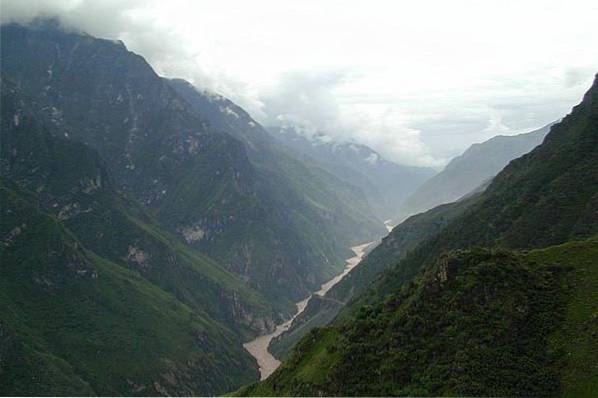
In China, south of the Yangtze River, there is a very peculiar mixed forest because it includes tropical species. Gymnosperms of the endemic family Pinaceae, species of Quercus and tropical species like Albizia macrophylla.
Central American mixed pine and oak forest (Nicaragua, Honduras, Guatemala)
They are mountain forests in which mainly pine and oak species are integrated. The most relevant combinations are Pinus oocarpa Y Pinus maximinoi with several species of the genus Quercus.
The species of Quercus more abundant are Quercus elliptical, Quercus pedunculatus, Quercus sapotifolia Y Quercus tristis. Additionally there are other species such as Liquidambar styraciflua Y Carpinus caroliniana and conifers like Juniperus comitana.
Due to its geographical location, this forest has elements of the flora from the north of the continent and the south. That is why there are species of the genera Pinus Y Quercus, as well as tropical species.
Among the tropical elements, the nanche (Byrsonima crassifolia) and the guabo (Inga punctata).
References
- Barbati A, Corona P and Marchetti M (2007). A forest typology for monitoring sustainable forest management: The case of European Forest Types. Plant Biosyst. 141: 93-103.
- Calow P (Ed.) (1998). The encyclopedia of ecology and environmental management. Blackwell Science Ltd. 805 p.
- García-Aranda MA, Estrada-Castillón AE, Cantú-Ayala CM and Pando-Moreno M (2011). Classification of nine mixed coniferous forest sites with the presence of Taxus globosa in the Sierra Madre Oriental, Nuevo León and Tamaulipas, Mexico. Botanical Sciences 90: 53-62.
- Kilgore BM and Taylor D (1979). Fire History of a Sequoia-Mixed Conifer Forest. Ecology 60: 129-142.
- Kira T (1991). Forest ecosystems of east and southeast Asia in a global perspective. Ecological Research 6: 185-200.
- Redd-Ccad-Giz Program (2011). Forest types and context of forest cover mapping in Central America and the Dominican Republic. Meeting of the technical liaisons for the MRV theme of the REDD-CCAD-GIZ Program. Guatemala. 18 p. reddccadgiz.org
- Sainz-Ollero H, Velázquez JC and Sánchez de Dios R (2017). Towards a classification of Spanish mixed forests 7th Spanish Forestry Congress. Spanish Society of Forest Sciences. Cáceres, Spain. 14 p.
- World Wild Life (Viewed on August 29, 2019). worldwildlife.org



Yet No Comments